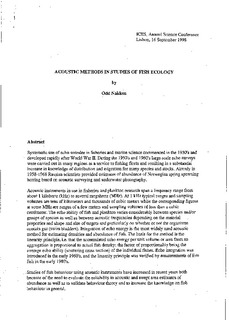| dc.contributor.author | Nakken, Odd | |
| dc.date.accessioned | 2008-07-01T11:23:22Z | |
| dc.date.issued | 1998 | |
| dc.identifier.citation | This report is not to be quoted without prior consultation with the General Secretary. | en |
| dc.identifier.uri | http://hdl.handle.net/11250/100349 | |
| dc.description.abstract | Systematic use of echo sounder in fisheries and marine science comrnenced in the 1930's and developed rapidly after World War II. During the 1950's and 1960's large scale echo surveys were carried out in many regions as a service to fishing fleets and resulting in a substantial increase in knowledge of distribution and migration for many species and stocks. Already in 1958- 1968 Russian scientists provided estimates of abundance of Norwegian spring spawning herring based on acoustic surveying and underwater photography. Acoustic instruments in use in fisheries and plankton research span a frequency range from about 1 kilohertz (kHz) to several megahertz (MHz). At 1 kHz typical ranges and sampling
volumes are tens of kilometers and thousands of cubic meters while the corresponding figures at some MHZ are ranges of a few meters and sampling volumes of less than a cubic centimeter. The echo ability of fish and plankton varies considerably between species and for groups of species as well as between acoustic frequencies depending on the material properties and shape and size of targets and particularly on whether or not the organisms contain gas (swim bladders). Integration of echo energy is the most widely used acoustic method for estimating densities and abundance of fish. The basis for the method is the linearity principle, i.e. that the accumulated echo energy per unit volume or area from an aggregation is proportional to actual fish density; the factor of proportionality being the average echo ability (scattering cross section) of the individual fishes. Echo integration was introduced in the early 1960's, and the linearity principle was verified by measurements of live
fish in the early 1980's. Studies of fish behaviour using acoustic instruments have increased in recent years both because of the need to evaluate the reliability in acoustic and swept area estimates of
abundance as well as to validate behaviour theory and to increase the knowledge on fish
behaviour in general. | en |
| dc.format.extent | 1026278 bytes | |
| dc.format.mimetype | application/pdf | |
| dc.language.iso | eng | en |
| dc.publisher | ICES | en |
| dc.relation.ispartofseries | ICES CM documents | en |
| dc.relation.ispartofseries | 1998 Opening Lecture | en |
| dc.title | Acoustic methods in studies of fish ecology | en |
| dc.type | Working paper | en |
| dc.subject.nsi | VDP::Agriculture and fishery disciplines: 900::Fisheries science: 920 | |
| dc.source.pagenumber | 22 s. | en |
